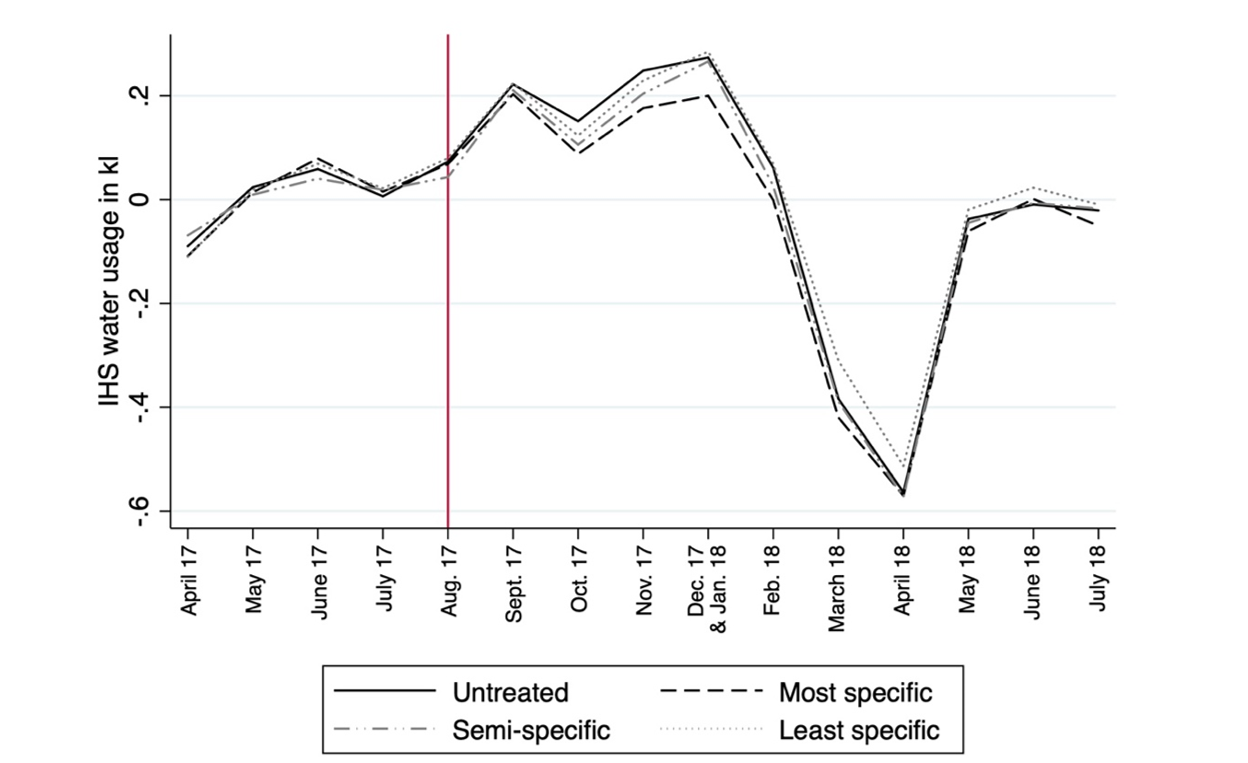
In Namibia, providing a short list of specific saving strategies reduced water consumption by 5% while simply raising awareness and asking households to find their own strategies was ineffective
Billions of people are affected by water scarcity. How can water demand be reduced?
Water scarcity is expected to be amongst the most disruptive effects of climate change and already affects two-thirds of the global population (Mekonnen and Hoekstra 2016). Extreme water scarcity not only influences human health and ecosystems but also has profound economic consequences. Lower-income countries are expected to be most affected by water scarcity because of their vulnerability and lower coping capacity. Yet, large-scale evidence on how to encourage water conservation from lower-income countries experiencing water crises remains scarce. In my research (Tonke 2024), I provide evidence from a randomised control trial (RCT) using a scalable, low-cost intervention to reduce piped residential water consumption. The study was conducted in 2017 in collaboration with the public water utility of Namibia. Namibia is one of the driest countries in sub-Saharan Africa and was severely water-stressed at the time of the RCT.
Do households know how to reduce their water consumption effectively?
Individuals often desire to achieve certain outcomes, but they potentially lack the procedural knowledge on how to do so, i.e. they do not know which specific actions or steps to take to change the outcomes. Could such a lack of knowledge inhibit effective water conservation? To test whether households possess the necessary knowledge to reduce water consumption, a sample of around 15,000 households was randomly split into three treatment groups and an untreated control group. All three treatment groups received saving strategies via text message on their mobile phones. The three treatments differed with respect to the specificity of the proposed water conservation strategies. Households either received very specific saving tips, which provided them with information about how to save water, or they were given less specific tips, which asked households to use or generate their own ideas to save water.
- Most Specific Treatment: Customers received three short and specific strategies, such as “shorten the time you spend in the shower by a minute or two” or “re-use water from cooking and cleaning food to water plants.” This list of strategies was designed to improve households’ procedural knowledge and targeted the three main self-reported domains of water usage (cleaning, bathing, and cooking), which were elicited in a pre-intervention survey.
- Semi-Specific Treatment: This text message contained suggestions on how to reduce water consumption in a specific domain, such as avoiding running water in the bathroom or re-using water from the kitchen, but households had to determine the exact activities themselves. Hence, the treatment relied on the households’ own knowledge and ability to find effective ways to reduce their water consumption.
- Least Specific Treatment: This treatment encouraged households to use and develop three strategies of their own. It asked households to stay alert, observe where too much water is being used, and to break current habits to save water in “their own way”. This treatment required a high level of involvement and procedural knowledge to be effective.
Key findings from a large-scale RCT
Providing a short list of very specific strategies is most effective. Figure 1 shows that the most specific treatment lowers water consumption the most. It reduces water consumption by around 5%. The effectiveness of the treatments decreases as they become less specific. Merely raising awareness about water scarcity without providing concrete savings advice is ineffective as it results in similar water consumption patterns as not providing information at all.
What explains the effectiveness of the most specific treatment? Factors like awareness of water scarcity or being asked to save water by the water utility are unlikely to be the mechanism behind the effectiveness of the most specific treatment since such factors are part of all treatments. Instead, the evidence supports the interpretation that many households lacked knowledge on how to save water. This is not only suggested by the increasing effectiveness of more specific treatments but is also supported by a pre-intervention telephone survey: around 92% of the respondents struggle to name more than one concrete strategy to save water.
Figure 1

This figure plots monthly water consumption for each experimental group over time. The most specific treatment lowers consumption the most. Treatment effects wane around March, at the onset of the rainy season.
- The most specific treatment reduces water usage almost instantly. This is particularly useful when disasters are imminent or unforeseen. The effect of the most specific treatment persists for about eight months but wanes with the onset of the rainy season in March, which alleviates the water scarcity.
- The treatment effects were driven by heavy users. The treatment effect is almost entirely driven by the subgroup with above-median water usage. This subgroup reduces its water consumption by about 8.7%. Heavy users are often the least price sensitive and have more room to reduce their consumption. Low users, who were already at or near subsistence levels of water usage, did not reduce their water consumption.
- No effects on utility bill payment. As a secondary outcome, I examine whether the intervention influences the payment of water utility bills. Many customers do not pay their water utility bills in full in this setting, which affects the fiscal sustainability (i.e., cost recovery) of the water utility (Rockenbach et al. 2023). I find that payments do not decrease. This implies that customers pay a larger amount of their bill since they consume less water without reducing payments.
Highly cost-effective intervention
The experiment reduced water consumption by about 22 million liters at a cost of around USD 800. This amount roughly corresponds to what 2,450 average households in the sample would use in a month. Had everyone in the sample received the most specific treatment, the campaign would have saved about 64 million liters. With water scarcity becoming an increasingly pressing issue worldwide, similar interventions could be tested in other water-stressed regions and be implemented widely, even by resource-constrained policymakers.
Conclusion: Interventions that focus on raising awareness or appealing to environmental consciousness – without giving specific, actionable, and salient advice on how to change – can fail to affect behaviour.
Environmental crises are expected to occur more frequently and more intensely, with devastating consequences on the functioning of organisations, industries, and society as a whole (IPCC 2021). In order to quickly respond effectively to such crises, policymakers need to identify and implement effective and scalable solutions to conserve resources. The article demonstrates that providing a short list of specific and actionable strategies effectively reduces water consumption by around 5%. Merely making individuals aware of water scarcity and asking them to use their own strategies is ineffective.
These findings highlight a critical aspect that is potentially overlooked in many mass communication campaigns. While people may already be willing to act sustainably, they may lack the precise knowledge on how to do so effectively. Campaigns that merely focus on raising awareness or appealing to environmental consciousness – without giving specific, actionable, and salient advice on how to change – can then fail to influence behavior.
References
IPCC (2021), "Climate change 2021: The physical science basis." Retrieved from https://www.ipcc.ch/report/ar6/wg1/downloads/report/IPCC_AR6_WGI_Full_Report.pdf
Mekonnen, M M and A Y Hoekstra (2016), "Four billion people facing severe water scarcity." Science Advances, 2, e1500323–e1500323. https://doi.org/10.1126/sciadv.1500323
Rockenbach, B, S Tonke and A Weiss (2023), "A large-scale field experiment to decrease non-payment for water: From diagnosis to treatment." Review of Economics and Statistics (forthcoming). https://doi.org/10.1162/rest_a_01363
Tonke, S (2024), "Providing procedural knowledge: A field experiment to encourage resource conservation in Namibia." Journal of Development Economics, 166: 103202. https://doi.org/10.1016/j.jdeveco.2023.103202

